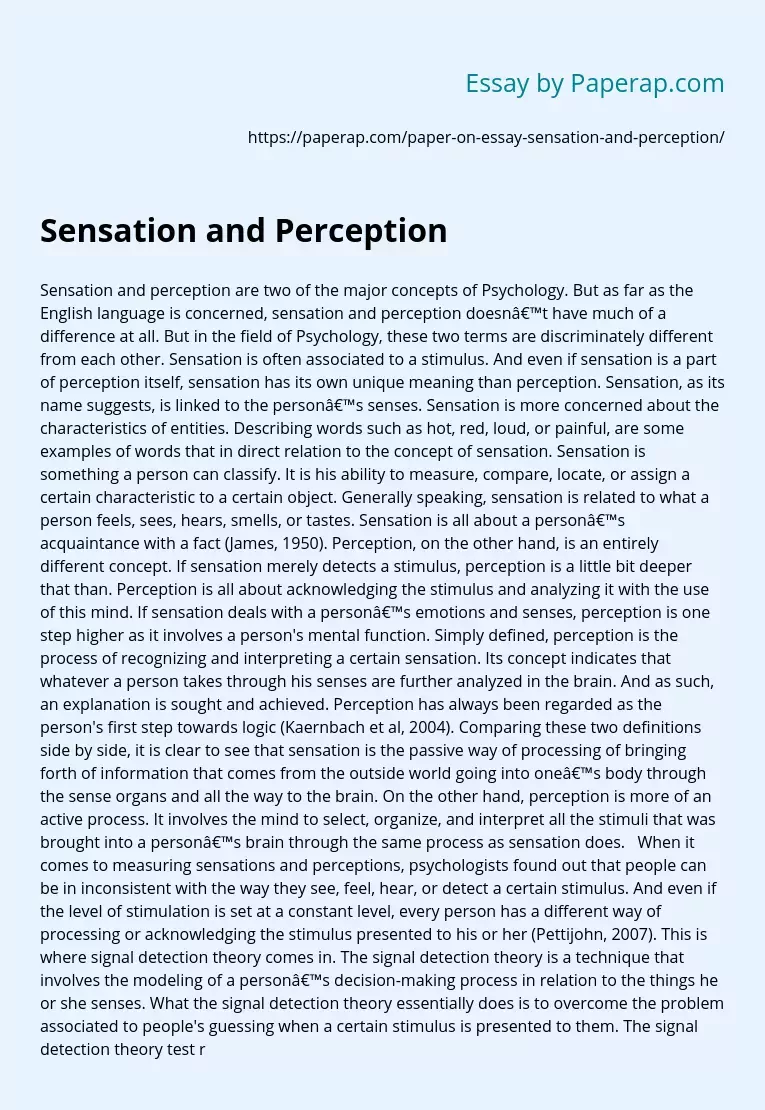Sensation and Perception
Sensation and perception are two of the major concepts of Psychology. But as far as the English language is concerned, sensation and perception doesn’t have much of a difference at all. But in the field of Psychology, these two terms are discriminately different from each other. Sensation is often associated to a stimulus. And even if sensation is a part of perception itself, sensation has its own unique meaning than perception.
Sensation, as its name suggests, is linked to the person’s senses.
Sensation is more concerned about the characteristics of entities. Describing words such as hot, red, loud, or painful, are some examples of words that in direct relation to the concept of sensation. Sensation is something a person can classify. It is his ability to measure, compare, locate, or assign a certain characteristic to a certain object. Generally speaking, sensation is related to what a person feels, sees, hears, smells, or tastes. Sensation is all about a person’s acquaintance with a fact (James, 1950).
Perception, on the other hand, is an entirely different concept. If sensation merely detects a stimulus, perception is a little bit deeper that than. Perception is all about acknowledging the stimulus and analyzing it with the use of this mind. If sensation deals with a person’s emotions and senses, perception is one step higher as it involves a person’s mental function. Simply defined, perception is the process of recognizing and interpreting a certain sensation. Its concept indicates that whatever a person takes through his senses are further analyzed in the brain.
And as such, an explanation is sought and achieved. Perception has always been regarded as the person’s first step towards logic (Kaernbach et al, 2004).
Comparing these two definitions side by side, it is clear to see that sensation is the passive way of processing of bringing forth of information that comes from the outside world going into one’s body through the sense organs and all the way to the brain. On the other hand, perception is more of an active process. It involves the mind to select, organize, and interpret all the stimuli that was brought into a person’s brain through the same process as sensation does.
When it comes to measuring sensations and perceptions, psychologists found out that people can be in inconsistent with the way they see, feel, hear, or detect a certain stimulus. And even if the level of stimulation is set at a constant level, every person has a different way of processing or acknowledging the stimulus presented to his or her (Pettijohn, 2007).
This is where signal detection theory comes in. The signal detection theory is a technique that involves the modeling of a person’s decision-making process in relation to the things he or she senses. What the signal detection theory essentially does is to overcome the problem associated to people’s guessing when a certain stimulus is presented to them. The signal detection theory test revolves around three main concepts: “hit”, “miss”, and “false alarm”.
“Hit” happens when a certain stimulus is offered to a subject and he says yes. This means he sensed the stimulus and acknowledged it correctly. It is also possible that no stimulus is presented and the subject says no. This means that his rejection of the stimulus is correct. It is a “miss” if the stimulus presented to the subject and he says no. This indicates that he was not able to detect the stimulus at all. “False alarm” is when a person says yes, he did detect the stimulus but then again, there was no stimulus presented to him at all.
Considering these concepts involving the tests of the signal detection theory, the probability of the subject correctly detecting the stimulus either presented or suspended from him is measured. Depending upon the accuracy of a person’s sensation and perception, he can accept or reject the stimuli that were presented to him.
Sensory adaptation is also referred to as neural adaptation. It is the change of a person’s sensory system over time when it comes to his responsiveness to a constant stimulus is concerned. A good example of sensory adaptation is when a person goes inside a movie theater. At first, everything is dark and it is impossible to find a seat without assistance. But after a few seconds, his eyes adjust to the unchanging stimulus, which is darkness, and everything becomes a little bit brighter and he begins to the things around him.
Sensory adaptation is referred to as the impermanent change to a person’s neural response to a steady stimulus. Sensory adaptation is believed to be a cause of the phenomena surrounding perception like motion after effects and after images. It is also the concept that causes a person’s visual perception to disappear or fade out in the lack of fixational eye movements.
Sensitization is a type of non-associative learning that involves the enhancement of a person’s reflex response by presenting a strong stimulus. Desensitization is the exact opposite of sensitization. If sensitization makes a person sensitive to a certain stimulus, desensitization removes that sensitivity by constantly presenting the same stimulus to him.
The most common and the simplest example of sensitization is when a person is exposed to certain substances, let’s say pollens. When your body detects pollens continuously or in increasing quantity, it reacts with a sneeze. It is also possible that the person develops illnesses like coughs and colds. And so the next time the body perceives the pollens, it recognizes it as a threat to health. Medicine terms it as allergens.
On the other hand, when a person undergoes desensitization, what actually happens is that he will be subjected to the very things that cause him allergies. And it is done with the intention of curing him out of it. Psychiatrists and psychologist usually use the desensitization process to treat people who are suffering from certain phobias.
Sensation and Perception. (2019, Jun 20). Retrieved from https://paperap.com/paper-on-essay-sensation-and-perception/

